

Treasures from the Sea
|
Have you noticed that one of the ingredients that is often used in Japanese food is seaweed? We can find it in sushi rolls, onigiri, miso soup, soup stock, side dishes and more. Certain varieties may also be made into agar-agar, and used as a plant-based gelatin substitute in confectionery. Considering that Japan is surrounded by sea and thought to contain around 1500 different varieties of seaweed, it is no wonder that many different types of seaweed are featured in Japanese cuisine.
Since ancient times, Japanese people have been eating seaweed. Traces of seaweed have been discovered at archaeological sites dating from the Jomon period. Historical texts have also recorded seaweed being offered as a gift to the Imperial court, as well as being used for tax payments. Besides that, various types of seaweed are among food offered to the gods in Shinto rituals. Due to its long shelf life, seaweed has been consumed throughout Japan long before the invention of refrigeration technology. It is also thought that seaweed plays a contributing factor to the long life expectancy of Japanese people. Not only is it low in calories, it is also rich in fibre, vitamins, minerals such as calcium, iron, magnesium and iodine. Furthermore, certain studies have shown other health benefits such as lowering cholesterol levels, keeping blood sugar levels from rising and boosting metabolism. Seaweed can be broadly categorised into three groups: brown algae, green algae and red algae. Brown algae includes numerous types of seaweed such as kombu, wakame, hijiki and mozuku. Kombu is a type of bull kelp and an essential ingredient for making soup stock, or dashi, due to its natural umami flavour. Majority of it is harvested in Hokkaido, and some can grow up to over 10 metres. It can also be preserved to make tsukudani, or turned into powder form to be made as tea. It is also wrapped around herring as a traditional New Year dish, kombu-maki, which represents health and longevity. Wakame is usually served in miso soup and salads, or it can be seasoned with vinegar. In fact, wakame only refers to the soft upper leaves, while mekabu refers to the tougher leaves closer to the root. Hijiki is commonly cooked with soybeans in soy sauce, sugar and mirin for a staple household dish. However, recent studies have shown that it absorbs high levels of inorganic arsenic from seawater and thus, it should be consumed in moderation. As it grows in coastal areas, it is usually collected when the tide is at its lowest. Mozuku has a chewy texture and is best enjoyed with vinegar. Majority of it is farmed in Okinawa. The red algae that most people are familiar with is nori, which is usually sold as dried flat sheets. Besides being used to wrap sushi rolls or onigiri, it is also used as toppings for rice bowls or noodles. As for green algae, the most recognisable one is umibudo, or sea grapes. Okinawa is Japan’s top producer of it, and it is also known as “green caviar”. Some novel ways of enjoying seaweed include adding seaweed flavouring to milk and creating ice-cream from it, fermenting seaweed to make miso soup that does not use soybeans, or mixing seaweed into soy milk to make tofu. We can expect to see more experimentation in how to use seaweed in cooking in the future too. Are there any interesting ideas that you can think of? |
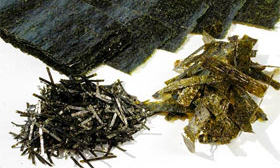 © Japan Up Close 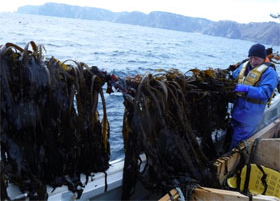 © Iwate Prefecture 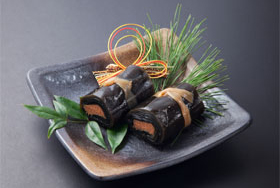 Kombu-maki © Web Japan 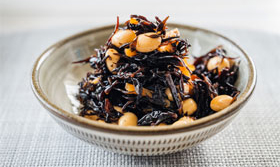 Hijiki © Web Japan 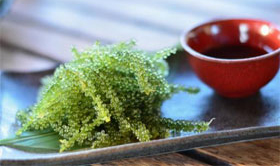 Umibudo © photoAC 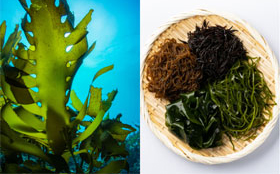 © Web Japan |
Resources
|
“Seaweed: The Edible Forests of the Ocean”. 2022. Web Japan. Accessed 18 August. https://web-japan.org/trends/11_food/jfd202211_seaweed.html. Tan, Rachel. 2019. “6 Most Common Varieties of Edible Seaweed”. MICHELIN Guide. https://guide.michelin.com/en/article/dining-in/6-edible-delicious-varieties-of-seaweed. Suganuma, Madoka. 2022. “A Guide to the 8 Most Common Types of Edible Japanese Seaweed”. Japanese Food Guide. https://www.japanesefoodguide.com/edible-japanese-seaweed-types/. “Japan’s Most Popular Types of Seaweed”. 2022. nippon.com. https://www.nippon.com/en/japan-glances/jg00134/. “Japanese Seaweed: All About 6 of Japan’s Most Popular Varieties!” 2018. LIVE JAPAN. https://livejapan.com/en/in-hokkaido/in-pref-hokkaido/in-sapporo_chitose/article-a0001961/. |
|
Japan Creative Centre 4 Nassim Road, Singapore 258372 +65 6737 0434 / jcc@sn.mofa.go.jp https://www.sg.emb-japan.go.jp/JCC/ Nearest parking at Orchard Hotel & Delphi Orchard |
 |